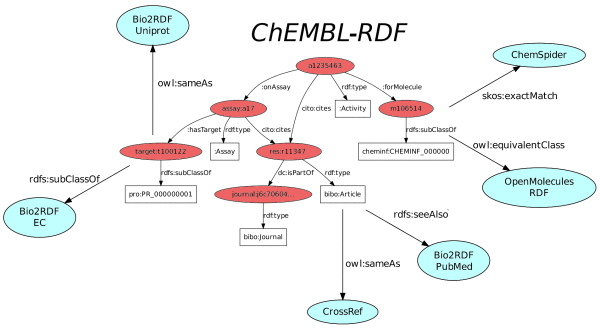New Paper: "The ChEMBL database as linked open data"
Update: Mark wrote up a blog post on the RDF that the ChEMBL team itself.
Yesterday, the paper “The ChEMBL database as linked open data” (doi:10.1186/1758-2946-5-23) by Andra Waagmeester (@andrawaag), Ola Spjuth (@ola_spjuth), Peter Ansell (@p_ansell), Antony Williams (@chemconnector), Valery Tkachenko, Janna Hastings, Bin Chen (@binchenindiana), David J Wild (@davidjohnwild), and me appeared in the OA JChemInf journal.
I am also indebted to the ChEMBL team (@chembl) for both providing such valuable data under a liberal Open Access license and their critical reading of the manuscript! Additionally, I would like to stress that the ChEMBL team will create their own RDF version of ChEMBL and that this paper is not describing the version they will release.
BTW, the source of the paper is available from GitHub. And the (original) scripts to create RDF from the MySQL dump of ChEMBL are also on GitHub.

This paper outlines the RDF as it has evolved from various earlier projects. The above diagram visualizes the basic structure (red), various Linked Data resources linked too (blue) and illustrates how various ontologies are used, such as the CHEMINF, BIBO, and CiTO ontologies.
Additionally, various applications and links are described developed by various co-authors. For example, Peter worked on the use in Bio2RDF and Bin and David on Chem2Bio2RDF. Andra developed an extension for his (#altmetric) CitedIn resource, giving credit to a paper when data in it is extracted into ChEMBL. Ola, Valery, and Anthony developed a Bioclipse Decision Support extension, which supports a nearest neighbor search in ChEMBL using ChemSpider. Of course, Ola also hosts the SPARQL end point of which you can monitor the uptime at the also cool mondeca.com service:

(Yes, I think I have all the cool buzzwords covered in this paper. Sadly, marketing is needed nowadays as a scientist. Where is the time that you could rant on page after page in all your domain specific jargon, not having to worry if your reader would understand it immediately, or without a university degree…)
What this paper does not describe, is all the things I did with ChEMBL-RDF in the Open PHACTS project (@Open_PHACTS), which includes the use of QUDT and the jQUDT library for unit normalization outlined in this document and the use of VoID for link sets as described in this document.